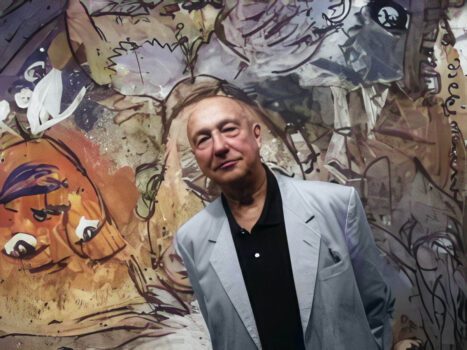What is Georg Baselitz Known For
In the landscape of post-war European art, few names resonate with the raw emotional gravity and rebellious spirit quite like Georg Baselitz. With a career that spans more than six decades, Baselitz has not only defied conventions but also forged a singular path that continually challenges the very nature of painting, sculpture, and national identity. Known for his iconic inverted portraits, expressionist vigor, and provocative themes, Baselitz remains a towering figure in contemporary art, a man whose canvases are as complex and uncompromising as the times he lived through.
A Childhood Framed by Ruins
Born as Hans-Georg Kern on January 23, 1938, in Deutschbaselitz, a small town in Saxony, Germany, Baselitz’s early life was deeply shaped by the trauma of World War II. The post-war rubble, the disillusionment with German nationalism, and the intense scrutiny of cultural identity would all become underlying threads in his artistic journey. His formative years were spent amidst the cultural vacuum left by Nazi censorship and Allied occupation, an environment that would influence his persistent questioning of authority and artistic orthodoxy.
After studying at the Academy of Fine and Applied Art in East Berlin, Baselitz was expelled in 1957 for “political immaturity,” a euphemism for non-conformity to Socialist Realist doctrines. He then relocated to West Berlin and enrolled at the Hochschule der Künste. It was there that his artistic philosophy truly began to evolve.
In 1961, he adopted the surname Baselitz, a nod to his hometown, and embarked on a journey that would make him one of the most disruptive and recognized artists of the 20th and 21st centuries.
Georg Baselitz is best known for turning his paintings upside down. This signature technique, first introduced in 1969, was not a gimmick but a conceptual strategy. By inverting his subjects, Baselitz challenged the viewer to see the image as paint and form, rather than as a representation of reality. It was an act of aesthetic rebellion, his way of saying that painting is not about narrative or identity but about surface, emotion, and process.
Some of his most well-known series include:
“Heroes” (1965–66): Depicting disheveled, wounded figures that reflect post-war German identity and guilt.
“Fracture Paintings” (late 1960s): Paintings with deliberate stylistic breaks or visual dislocations.
“Upside-Down Paintings” (1969 onwards): Portraits, landscapes, and still lifes all inverted to subvert traditional composition.
This inversion became a visual metaphor, a way to disconnect from historical burden and reframe how we understand visual representation.
How Famous is Georg Baselitz?
In the world of contemporary art, Georg Baselitz is a towering figure. His works have been exhibited in virtually every major museum and biennial. The Museum of Modern Art (MoMA) in New York, the Centre Pompidou in Paris, the Tate Modern in London, and the Guggenheim have all showcased his pieces.
He was the first living artist to exhibit at the Palazzo Grimani in Venice (2019), and his retrospective shows routinely draw international acclaim. Baselitz has also represented Germany at the Venice Biennale and held professorships at prominent art academies. He’s received numerous awards, including the Praemium Imperiale, often considered the Nobel Prize for the arts.
Not only is Baselitz respected in academic and curatorial circles, but he also enjoys a robust market presence, with collectors and galleries competing for his works.
How Does Georg Baselitz Create His Art?
Baselitz’s artistic process is deeply physical, gestural, and emotional. Rooted in German Expressionism, his technique blends forceful brushwork, thick impasto, and a vivid palette with existential themes.
Here’s a look at his typical process:
1. Inversion as a Method
When Baselitz began painting subjects upside down, he would sketch or plan the composition right-side up and then rotate the canvas. Over time, however, he trained himself to paint directly in this inverted mode. This made the act of painting less about representation and more about formal relationships, color, texture, and shape.
2. Aggressive Brushwork
His canvases are often painted with rapid, almost violent strokes. The surface becomes a battleground of expressive tension, revealing the psychological undercurrents behind each image.
3. Sculpture as Brutal Form
Baselitz’s sculptures are just as raw and evocative as his paintings. He often uses chainsaws and chisels to carve large wooden figures, leaving them rough and gouged. The brutality of the carving process echoes the emotional brutality of his subject matter, broken bodies, fractured ideologies, and uneasy beauty.
4. Recurring Themes
His work often revisits themes of German guilt, identity, war, nationalism, and masculinity. Yet, despite the heaviness, there is a strange optimism, a belief in the act of creation itself as redemptive.
How Much Does Georg Baselitz’s Art Cost?
Baselitz’s art commands millions of dollars at auction. His record-breaking sales reflect both his critical stature and collector demand.
Here are a few notable figures:
In 2019, his painting “Mit Roter Fahne (With Red Flag)” from 1965 sold at Sotheby’s for $10.6 million.
Other paintings, especially from his “Hero” and inverted series, typically sell in the range of $1 million to $7 million depending on size, provenance, and rarity.
Smaller works on paper or prints may range from $20,000 to $200,000.
Collectors view Baselitz’s work as not just emotionally potent but also a stable investment, given his consistent presence in museum retrospectives and major exhibitions.
How Many Artworks Does Georg Baselitz Have?
It’s difficult to pinpoint the exact number of artworks created by Baselitz, but his output is prolific. Over six decades, he has produced:
Hundreds of large-scale oil paintings
Dozens of monumental wooden sculptures
Thousands of works on paper (etchings, lithographs, and drawings)
Numerous prints and editions
His catalog raisonné (the official register of all his works) is still being compiled, but scholars estimate that he has produced well over 2,000 unique pieces, not including preparatory sketches and smaller editions.
What Art Style is Georg Baselitz Associated With?
Georg Baselitz defies easy categorization, but he is most commonly associated with:
1. Neo-Expressionism
Baselitz is a leading figure in Neo-Expressionism, a movement that emerged in the late 20th century as a reaction against conceptual and minimal art. Characterized by bold colors, figurative distortion, and emotional rawness, Neo-Expressionism revived painting’s expressive and personal qualities.
2. German Expressionism
While not a part of the original Expressionist movement (like Kirchner or Nolde), Baselitz draws heavily from their legacy. He channels their angst, gestural energy, and fascination with the grotesque.
3. Postmodern Figuration
Unlike abstractionists, Baselitz never abandoned the figure, but he deconstructed it. His figures are distorted, inverted, or dismembered, forcing the viewer into an uneasy engagement with form and meaning.
What Materials Does Georg Baselitz Use?
Baselitz’s material palette is as intense as his imagery. He employs a wide variety of media, depending on the work’s nature:
For Paintings:
Oil and Acrylic Paint: Often applied thickly, with aggressive textures.
Canvas or Wood Panels: Large surfaces allow for expansive gesture and compositional experimentation.
Graphite and Ink: Used for preparatory drawings or stand-alone works on paper.
For Sculpture:
Wood (often Limewood or Spruce): Baselitz carves directly into logs with chainsaws and hand tools.
Bronze: Many of his wood carvings are later cast in bronze, preserving the roughness of the original.
Polychrome Finishes: Sometimes his sculptures are painted, adding a primitive, totemic quality.
For Prints:
Etching and Lithography: His print work maintains the same emotional immediacy and often revisits themes from his larger paintings.
Georg Baselitz Today
Now in his late 80s, Georg Baselitz continues to create with undiminished intensity. His recent exhibitions, such as “Archipelago” and “Naked Masters”, show an artist reflecting on mortality, aging, and legacy. But even in these later works, his rebellious spark remains.
In 2021, Baselitz made headlines when he donated six of his major paintings to the Musée national d’art moderne (Centre Pompidou) in Paris. This was a symbolic gesture, an offering of his life’s work to posterity, free from market pressures.
He lives between Germany and Italy, continuing to paint and sculpt almost daily. His wife Elke, often a muse in his work, remains his lifelong partner in both art and life.
Georg Baselitz’s story is not just about turning paintings upside down. It’s about challenging how we perceive history, identity, and the function of art itself. In a world increasingly polished and curated, Baselitz offers something raw, honest, and unflinching.
He paints not to please but to provoke. He carves not to idealize but to confront. His works are scars on the cultural landscape, permanent, unapologetic, and deeply human.
Whether you encounter a splintered sculpture or a fiercely abstracted portrait, a Baselitz piece doesn’t merely hang on the wall, it confronts you, pulls you into its orbit, and leaves you changed.
And in that confrontation lies his true genius.




